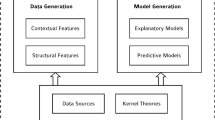The study of patterns of behaviour and the grouping of users according to exhibited behaviour is called behavioural profiling. Behavioural profiling uses detailed records of the relationship between the organisation and the user, such as records on product usage, account balance or transaction history. Beyond just knowing that someone did something, behavioural profiling involves capturing records of events and actions over time and using these stored records of interactions to model typical behaviour and deviations from that behaviour. Sometimes, this is augmented with data from outside databases, such as census data.
Behavioural profiling is performed through data mining, a process that ranges from data selection and preparation to post processing and includes the interpretation of the emerging results. This chapter provides an overview of the process of data mining, including a discussion of the main models and algorithms used and a reflection on the relationship between these and the objectives of the data mining exercise – e.g., an inductive process that aims to uncover patterns or relationships previously unknown versus a deductive process that looks for confirmation, or indeed departures, from accepted patterns or models of behaviour.
Data mining has its origins in quantitative disciplines, including the artificial intelligence community (e.g., machine learning and pattern recognition) and the mathematical community (e.g., statistics and uncertainty processing). However, human cognitive factors can deeply affect the results of a data mining effort. This chapter concludes with a discussion of how the data mining user can influence the outcomes of data mining.
Access this chapter
Tax calculation will be finalised at checkout
Purchases are for personal use only
Preview
Unable to display preview. Download preview PDF.
Similar content being viewed by others
References
Canhoto, I.A. and Backhouse, J., ‘Constructing categories, Construing signs – analysing differences in Suspicious Transaction Reporting practice’, IS-CORE 2004 – 4th Annual SIG IS Cognitive Research Workshop, 2004.
Canhoto, A.I., ‘Ontology-based interpretation and validation of mined knowledge: Normative and cognitive factors in data mining’, in Nigro, H. O., Cisaro, S. E. G. and Xodo, D. H., Data mining with ontologies: implementations, findings, and frameworks,. Hershey, NY, Information Science Reference, 2007, pp. 84–105.
Chan, C. and Lewis, B., ‘A Basic Primer on Data Mining’, Information Systems Management, Vol. 19, No. 4, Taylor & Francis, Inc. Philadelphia, 2002, pp. 56–60.
Fayyad, U., Piatetsky-Shapiro, G. and Smyth, P., ‘The Kdd Process for Extracting Useful Knowledge from Volumes of Data’, Communications of the ACM, Vol. 39, No. 11, ACM Press, New York, 1996, pp. 27–34.
Gibson, J.J., The Ecological Approach to Visual Perception, Houghton Mifflin Co, Boston, 1979.
Humby, C., Hunt, T. and Phillips, T., Scoring Points: How Tesco Is Winning Customer Loyalty, Kogan Page, London, 2003.
Liebenau, J. and Backhouse, J., Understanding Information: An Introduction, Macmillan, London, 1990.
Shearer, C. ‘CRISP-DM Model: The New Blueprint for Data Mining’, Journal of Data Warehousing, Vol. 5, No. 4, The Data Warehousing Institute. 1105 Media, Inc, Chatsworth, CA, 2000, pp. 13–23.
Silberschatz, A. and Tuzhilin, A. ‘What Makes Patterns Interesting in Knowledge Discovery Systems’, IEEE Transactions on Knowledge and Data Engineering, Vol.8, No. 6, IEEE Computer Society, Washington D.C, 1996, pp. 970–974.
Author information
Authors and Affiliations
Editor information
Editors and Affiliations
Rights and permissions
Copyright information
© 2008 Springer Science + Business Media B.V
About this chapter
Cite this chapter
Canhoto, A., Backhouse, J. (2008). General Description of the Process of Behavioural Profiling. In: Hildebrandt, M., Gutwirth, S. (eds) Profiling the European Citizen. Springer, Dordrecht. https://doi.org/10.1007/978-1-4020-6914-7_3
Download citation
DOI: https://doi.org/10.1007/978-1-4020-6914-7_3
Publisher Name: Springer, Dordrecht
Print ISBN: 978-1-4020-6913-0
Online ISBN: 978-1-4020-6914-7
eBook Packages: Computer ScienceComputer Science (R0)




